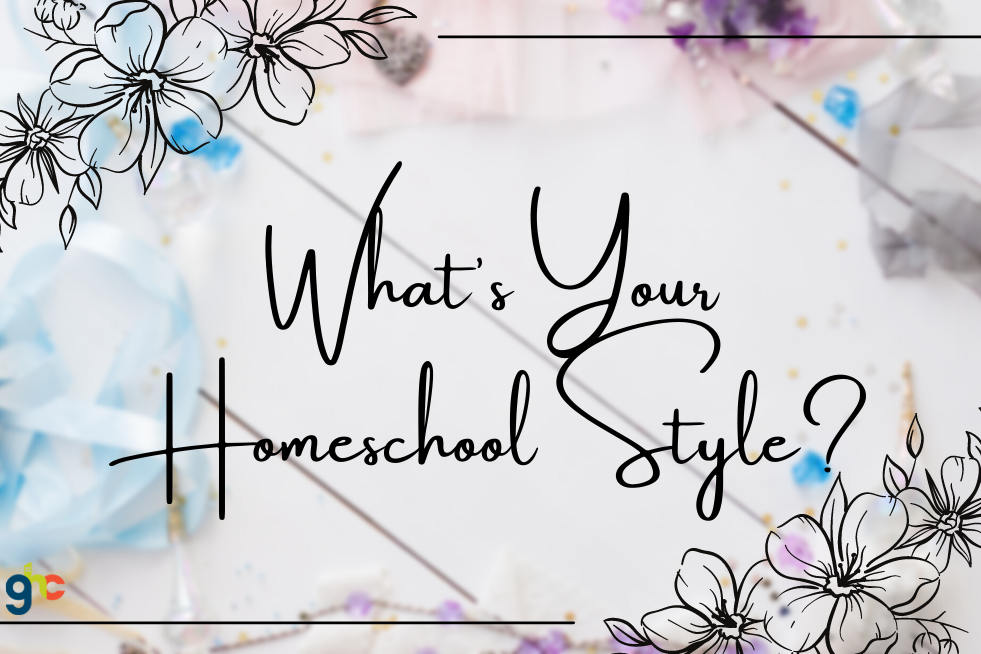One of the first things you’ll have to think about as you begin your homeschooling journey is, What homeschool style should I use? Whereas some families simply begin with the understanding that homeschool is NOT “school at home,” others might not be entirely sure about how to get started. And that’s okay! We want to help familiarize you with the different styles that are available so that making this one decision won’t overshadow everything else.
I’ll also note here a fact I wish someone had told me earlier in our homeschooling endeavor because as small as it sounds, it can make a huge difference. If you start your homeschool year with one particular method, especially if it’s your first year, PLEASE KNOW that if it absolutely does not work, there’s no reason you have to stick it out. Remember: this is YOUR school and YOUR child, and you’re going to make changes along the way. ALL homeschool students are different! If switching from one style or method to an entirely different one is what you think is necessary, there’s no reason not to--at any time!
So, with that in mind, we’ll jump right into some great information about the various styles available to you.

The Relaxed Homeschool Style
Relaxed homeschooling sounds like a pretty simple term, in both definition and execution. But once you actually start looking for the nitty-gritty on ‘style’, you’ll find there’s just not a lot of resources out there. That doesn’t mean it should be cast aside as a viable option, though. In fact, it could be the one that works best for you, popular or not.
Many new homeschoolers, or homeschool outsiders, sometimes equate Relaxed Homeschooling to Unschooling. It’s true, there are some similarities, but they are actually quite different at their core. In Relaxed Homeschooling, for instance, you’ll find the parent is always at the helm of the child’s learning experience, and although there may be fewer pieces of homeschool curriculum, there are still many certain things considered “critical” for the education process.
If your child is in high school and attempting to prep for college, Relaxed Homeschool isn’t always the best course. It doesn’t adhere as tightly to rigorous schedules and tons of bookwork, nor is there an emphasis on test scores and progress reports. While you can still achieve a high school diploma with this style, the child homeschooled in a Relaxed environment is more likely to succeed in general life settings instead of the academic realm alone.
There are some really great advantages to the Relaxed method. At the risk of sounding obvious, it is much more relaxed than some other styles. It’s also easy to change things around if unforeseen situations come up and you can literally carry on with your child’s learning anywhere. I’ve often homeschooled at the park, in a doctor’s office, on vacation in a different location… the possibilities are endless. Even having a cold won’t hamper the learning experience, because you can always switch to a video or program that falls in line with whatever you’re learning at the moment. And finally, it gives your children ample time to think for themselves!
The Unschooling Style
Those who don’t know very much about homeschooling are most likely to raise eyebrows about this method because it simply doesn’t sound good to them. To the world, “Unschooling” screams out, We don’t really homeschool, we just say we do! But that’s not true at all. Having used the Unschooling approach with my own daughter, I can tell you, it’s actually surprising what your children can accomplish when they get to lead a portion of the process.
I’ll take just a moment here to mention Radical Unschooling, as it does fit in this category. It’s a method in which all learning and decisions are primarily left up to the child and isn’t confined simply to the academic aspect of their lives. These children are often permitted to choose their own bedtimes, what they want to eat every day, and more. “Radical” Unschooling certainly isn’t for everyone, but there are those who seem to make it work.
Unschooling, in and of itself, is a way to allow your child to experience, and learn from, the world around them as a whole. This style is very interactive for kids as they use their own interests to guide their learning. These children often have many social interaction opportunities in the real world and, as their inquisitiveness grows, so will their knowledge base. It is a sort of unspoken rule that as children grow and learn new things, there is an innate pursuit of knowledge that happens as a result of needing to move forward. I’ve seen this to be true for the most part, every time it’s tried.
Some parents are hesitant to try this approach to homeschool because they fear it can get out of hand. Whereas that is certainly true, it’s a good idea to keep it on the back burner, especially as your child ages. You’ll find out more about how they naturally do things, which will, in turn, help you to help them figure out their true learning style.
The Eclectic Homeschool Style
In this home education style, you’ll see hints of both Unschooling and Relaxed Homeschooling, but it remains a separate category, even if only for the simplest of reasons. Eclectic homeschoolers often borrow from various different curriculum sets and other resources. It doesn’t maintain its own creed or a strict set of rules, and every family that uses it will do so differently. But for many, that’s one of the advantages that really makes it worthwhile.
There’s no doubt that our children are all different. I know my own two are as different as NIGHT AND DAY. What one is, the other isn’t, and vice-versa. Everything that worked wonderfully for my above-average, knowledge-hungry daughter was thrown out the window with regard to my high-functioning, social-butterfly son. And that’s how it goes sometimes. That is what worked best for our family, and you will have to find what works best for yours. That is part of the beauty of homeschool, you can take things as fast or slow as you need to. YOU can decide what grade level your child needs to be at and how they will learn the best.
You can sort of compare building an Eclectic Homeschool program to building a house. It all starts with a good foundation. Think about the things that are most important overall, your goals for the school year, and what you would like to use to reach those goals. Using a curriculum guide can help in this process, especially if you’re going to be picking and choosing from more than one.
With this style of homeschooling, in particular, actually GETTING YOUR HANDS ON THE CURRICULUM you’re considering is very important! There is no best homeschool curriculum, it is all about what works for you and your own family. That’s why you’ll want to consider attending a Great Homeschool Convention. There, you’ll get to examine a huge variety of resources, meet with other wonderful educators, and get valuable information from the speakers and vendors in attendance. This isn’t an opportunity you’ll want to let slip by, as it could prove to be a major turning point in your style, your materials, and not least of all, your level of confidence!
The Charlotte Mason Homeschool Style
If you choose the Charlotte Mason homeschooling style, you will note that there is no set curriculum. This style is a culmination of doing things a certain way based on the idea that children are absolutely capable of learning in their own way.
Within this style of homeschooling, the lesson plans are kept short and in lieu of textbooks, resources such as biographies, poetry, and Scripture are used instead. Narration is a major tool in understanding how much a child learns. Up until the child is ten years of age, the oral narration is expected in the retelling of the information they learn. After that, the written narration becomes the focus. Copy work and dictation are also major avenues of learning in the Charlotte Mason style, especially for reading and grammar.
The study of nature, music, and the arts was of the utmost importance to Ms. Mason. These electives take on a major role in helping children to understand the world around them, balancing their education, and helping them to become truly well-rounded citizens. Free afternoons are also very important in this style, giving children the opportunity to grow in crafts, hobbies, and allowing their own interests to rule their free-time learning experiences. Lots of this style can be done with things in your own home.
In understanding how to teach this style, you should familiarize yourself with the fact that Ms. Mason expected a certain level of knowledge at certain age levels. You should also know that you do not have to adhere to her own lists and levels. Making your own can be just as beneficial, and sometimes more so since you know your own child’s character and ways of learning. You can certainly use her list as a springboard for your own ideas, but allowing your heart to lead-based on your child’s specific needs, is always best.
For more information on the Charlotte Mason style, check out our blog post entitled, A Guide To Charlotte Mason’s Method Of Teaching.
The Classical Homeschool Style
The Classical homeschooling style is known as an “ancient” way of teaching. Having started as far back as the Middle Ages, it incorporates a certain method to both teaching and learning. These methods are utilized at specific levels. Instead of making the transition according to age, they are made with respect to whether the child has an actual grasp on the information put forth in the specific stage they are in.
The first stage relates to preparation, and it’s where the idea of “the three r’s” comes into play: reading, ‘riting, and ‘rithmethic. Of course, the misspellings used to turn them into a quip certainly serve no purpose in the Classical style, it’s still a fun little way to remember it. Reading, writing, and math are foundational elements in this style and a firm grasp of these allows the child to move on to the next stage, which is grammar. From there, the more subject matter is added as you research-related content. The final phase is based on communication and shows a command of everything that comes before.
Much like the Charlotte Mason style, living books are a major component of the Classic method. These can be a part of a strict curriculum, or you can compile your own resources based on specific standards you have set forth for yourself and your child.
Overall, the core strategy of a Classical education focuses on Math, History, Language Arts, and Science, but it also emphasizes logic and the learning of the Latin language. Character education also plays a role in helping children learn to draw their own conclusions about the information they have fully analyzed.
The Unit Studies Homeschool Style
Also known as “Themed Unit Study,” the Unit Studies style allows you to flow across all subject areas, teaching from a specific theme or unit. The overall goal is to study specific topics deeply where the result will be a complete mastering of the information. Taking a look at the same thing from different points of view can train and retrain, causing the information to be more easily grasped.
There are some specific situations in which this particular method can be best utilized. For instance, if the children you are homeschooling are all different ages, if you have special needs students if you’re on a low-budget, or even if you just want to try something that isn’t quite so traditional, the Unit Studies method can really be a win for your whole family.
Unit Studies is an excellent style if you have a child that is easily bored. In the public-school setting, boredom is most usually given a label, and then they expect you to medicate that ‘label’ into submission. The truth is, sometimes it’s just as simple as removing the boring drudgery to truly open up a world of learning for the child!
It can also help to create a natural curiosity which then turns into a passion for the accumulation of knowledge. We call it “learning,” but to your child, it could be a step in exploring another piece of the whole world! Just think about taking off the limits of your child’s potential and you’ll have an idea of what Unit Studies will allow them to cultivate.
For an idea of how Unit Studies work, let’s consider the subject of dogs. For Math, you could learn about how to feed a dog according to weight, or how fast certain dogs can run. In Language Arts, you could read about them and have your copy work reflect the theme. Geography could focus on where specific breeds come from, while in Science, you can watch videos or read books on a dog’s first year and how they grow. For art, making a felt board with pieces that look like dogs, dog houses, food bowls, etc., can make learning fun. And for a field trip, you could visit a local pet shop or animal shelter, speak with those who work there, and interact with the dogs.

In Closing…
Choosing your own homeschooling style, and one that works best for your children is a deeply personal thing. I encourage you to take your time while researching and dive deep into any style you think might work for you.
One of the best ways to review resources and get answers to your most pressing questions is to attend one of our Great Homeschool Conventions! Our vendors and speakers are there for YOU and will be happy to help.
To get registered to attend one of these conventions, just CLICK HERE.
For more blog content, CLICK HERE.
But most of all, remember that our seven (7) regional “Great Homeschool Conventions” are: Equipping… Encouraging… FUN!
